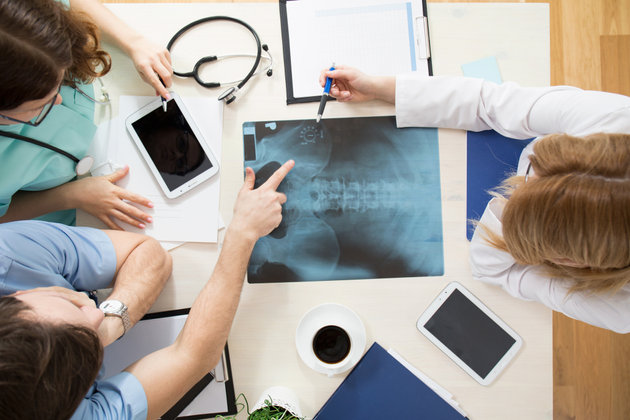Hip Fractures and Treatment
With aging, weakening of bones and problems such as balance and vision increase the risk of hip fractures as a result of falls.

With aging, weakening of bones and problems such as balance and vision increase the risk of hip fractures as a result of falls. Hip fractures, which are a significant trauma and especially affect the elderly population, are a serious injury. The risk of hip fractures, which sometimes lead to life-threatening complications, increases with age. Because the weakening of bones due to osteoporosis, balance and vision problems in the elderly increases the risk of hip fractures as a result of falls. Anadolu Health Center Orthopedics and Traumatology Specialists Assoc. Dr. İbrahim Akmaz and Op. Dr. Mehmet Taner Özdemir reminds us that the treatment of hip fractures is almost always surgical. In this article, we share all the details about the subject in line with the information provided by both of our experts.
Most Common Age: Over 65 Years of Age
The majority of hip fractures occur in elderly individuals over the age of 65. While these fractures generally occur as a result of falling while walking, let us underline that an average of 70% of the patients are women. Well, aren’t there any young people? Of course, hip fractures in young people constitute one tenth of all cases. These generally occur due to high-energy traumas such as traffic – work accidents and sports injuries.
First Findings in Hip Fracture
In hip fracture, after a fall, patients feel pain in the hip and groin area and cannot walk. They cannot move their hips or have great difficulty. Swelling and bruising may occur on the fractured side. The leg on the broken side appears shortened.
Treatment: Surgery
The treatment for a broken hip is surgery. In general, internal orthopedic implants (plates, screws and nails) can be used to unite and fuse broken bones, or the broken bone can be removed and replaced with a metal prosthesis.
Preparation for Surgery
Preparing elderly patients for surgery; It is performed after reviewing existing chronic diseases, revealing the reasons for the fall, and ensuring optimal conditions (transfusion preparations and intensive care requirements). Surgical options are decided by looking at some characteristics of the patient and the fracture:
- – Anatomical location of hip fracture.
- – Orthopedic technical classification of fracture.
- – Quality of bone.
- – The patient’s condition (duration of surgery, expected blood loss and existing diseases should be taken into consideration).
What are the risks?
There are risks during the surgical process that may negatively affect the treatment of patients. These are clot formation and expulsion (thrombus and embolism), bedsores, urinary tract and lung infections, nutrition and defecation problems, muscle weakening and wasting. To reduce these risks, blood thinners should be used, breathing exercises, adequate fluid intake and a special nutrition program, in-bed exercises and appropriate patient care should be performed.
After the surgery, the patient’s rehabilitation, regaining his walking ability, making him self-sufficient, and eliminating the factors that cause the fracture should be followed as an important process. Rehabilitation should begin immediately after surgery and continue at home after the patient is discharged. The patient should be made self-sufficient with a dynamic and functional training program and efforts should be made to help him/her achieve an independent lifestyle before the fracture.
Risk Factors for Hip Fractures in the Elderly
- osteoporosis
- Gender (Most cases are female patients)
- Not doing sports and exercise
- Cigarettes and coffee consumption
- Not getting enough protein, calcium and vitamin D through diet
- Use of some medications: Cortisone group drugs that reduce bone density, sleeping pills used for neurological disorders, antidepressants, epilepsy drugs can affect balance and coordination ability and increase the tendency to fall.
- Some diseases (such as intestinal diseases that affect calcium and vitamin D absorption, thyroid disorders that can lead to bone weakness, dementia and Parkinson’s disease that cause balance and coordination problems)
8 Important Points for Protection!
It is important to build a healthy lifestyle to prevent hip fractures. This is all about applying the suggestions below…
Adequate nutrition: Get protein, calcium and vitamin D.
People over the age of 50 should take 1200 mg calcium and 600 IU vitamin D per day, after consulting a physician.
To exercise: Walking increases your overall muscle strength, maintains your sense of balance, and strengthens your bones.
Smoking and excessive coffee consumption: Reduce or leave it as much as possible.
Dangers at home: Mount electrical cables on the edges of walls and take necessary precautions for slippery surfaces (bathrooms and toilets). Arrange furniture and items that will provide easy access to every room of the house (especially the toilet), and eliminate elevations that will cause tripping.
Eye examination: Do not skip your annual examinations.
Existing internal diseases: Do not neglect monitoring diseases such as diabetes, blood pressure, dementia and ensuring the medication used is in order.
Ahgetting up slowly to the net: Remember, sudden starts can cause low blood pressure and balance problems.
Use of cane – crutches: It should be used by those with balance and vision problems to prevent falls.
Nearly half of elderly patients who sustain a hip fracture cannot return to their preoperative independent and unaided lifestyle. Therefore, it is very important to take the necessary precautions to avoid falling.



